September 4, 2018–February 10, 2019
Rosedale Gallery
Arcadia Exhibitions is pleased to present “Carole Loeffler: Make What You Need”, an exhibition of ten new text-based fabric works in the Rosedale Gallery located on the ground floor of the University Commons. The first iteration of this new Faculty Focus series, the show remains on view through February 10, 2019.
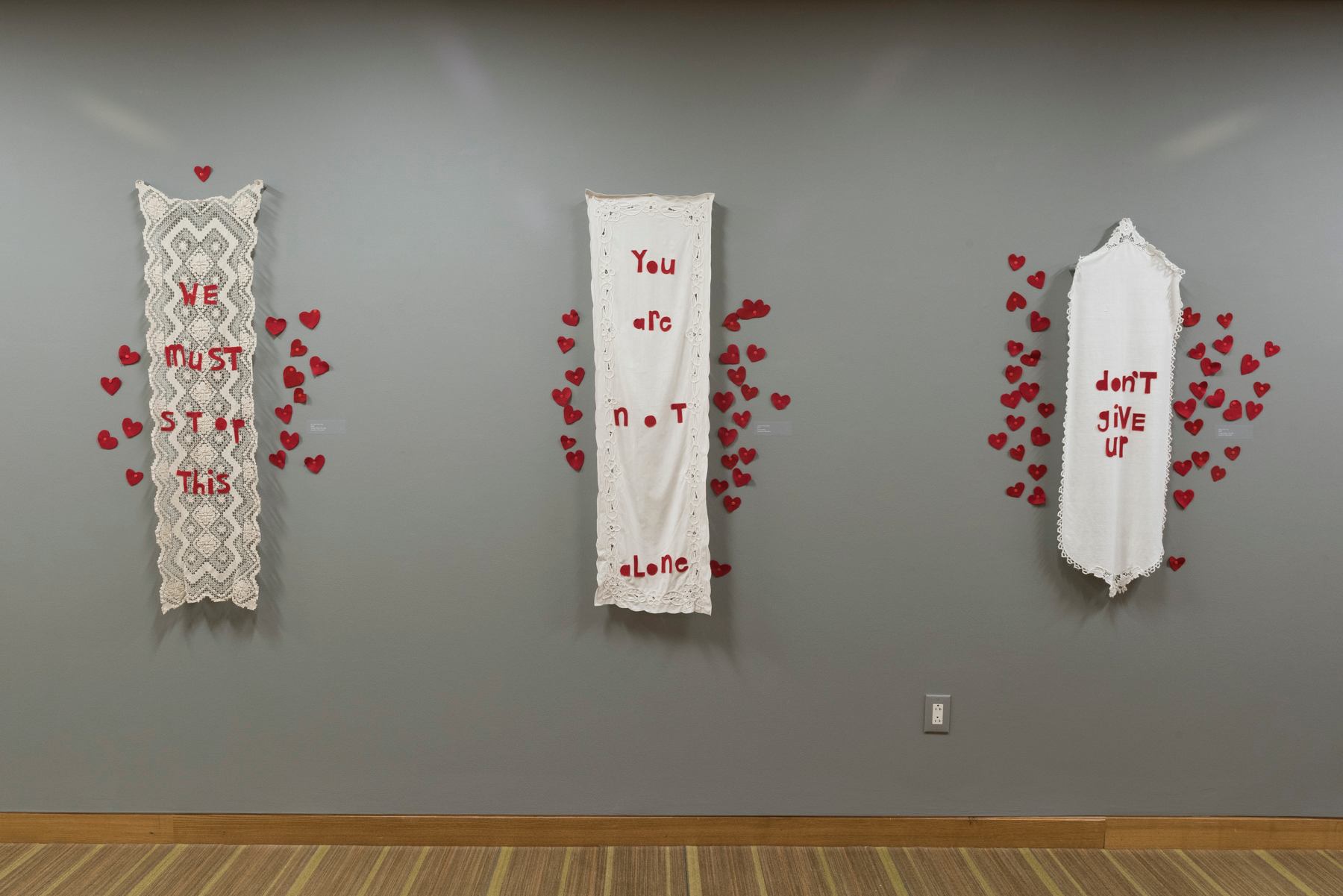
Installation view, "Carole Loeffler: Make What You Need", (left to right), We Must Stop This (2018), You Are Not Alone (2018), Don't Give Up (2018), Rosedale Gallery, photo: Sam Fritch
Each piece on view consists of either a vintage table runner or ornate doily — embellished with encouraging or defiant texts such as “You are Invincible”, “I Will Not Break”, or “Don’t Give Up”. Each message is rendered in hand-cut red felt letters.
These works are recreations of pieces Loeffler first hung in public spaces on brick walls, metal doors and telephone poles throughout Philadelphia beginning in January 2018. Entitled “Granny Graffiti”, these gestures were initiated by Loeffler to produce random moments of empowerment and positivity for the occupants of the neighborhoods she frequents. Due to the ephemeral nature of these works (the originals are no longer where she placed them and their current whereabouts are unknown), Loeffler also documents her installations and posts them on social media, both as a means of preserving the activity and to expand the audience able to encounter her affirmations.
The specific messages selected for this exhibition were chosen based on their online popularity as determined by the number of likes the documentation received on her Loeffler’s Instagram feed. (instagram.com/caroleloeffler) Additionally, for this particular show, Loeffler has provided a supply of hand-cut, red felt hearts, which visitors are encouraged to pin on the wall near the pieces they like – an analog equivalent to the social media experience which accompanies these works when installed outside the gallery context.
The lion’s share of Loeffler’s artistic output prior to the “Granny Graffiti” series is distinguished by a combination of playfulness, repetitive activity to the point of obsession, devotion to the color red, and an overall love of material experimentation. Though these earlier works can be deliberately anthropomorphic, and sometimes incorporate recognizable images or sounds, Loeffler’s visual vocabulary to this point in her career has been decidedly abstract.
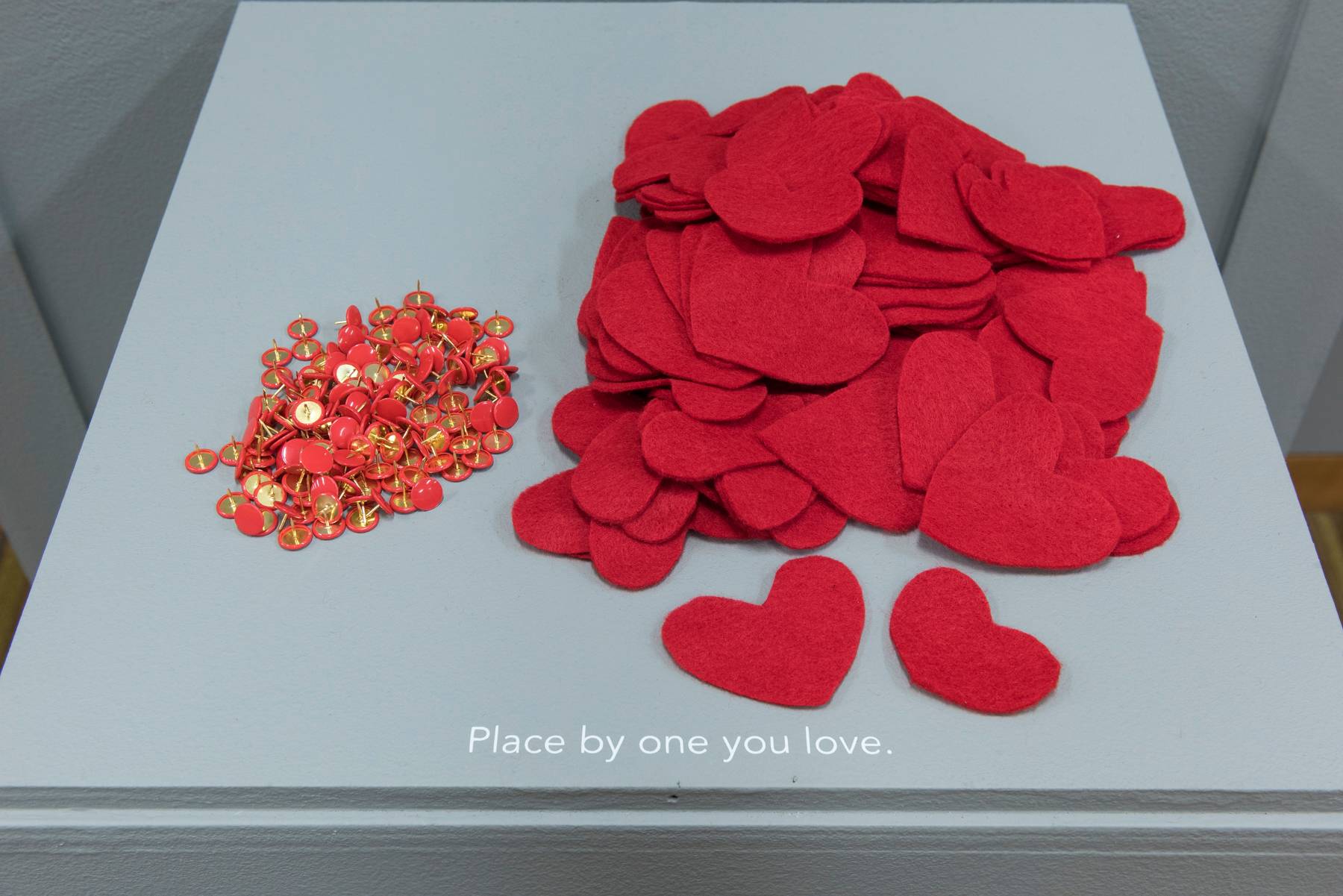
Installation view, "Carole Loeffler: Make What You Need", supply of felt hearts and red tacks, Rosedale Gallery, photo: Sam Fritch
The recent introduction of text into her work, “a reaction,” according to Loeffler “to the toxic post-election, political environment that is enveloping the United States and the world,” exhibits a new sense of urgency to communicate and to be understood in a more direct way. The striking contrast between the speedily-cut, red felt letters adhered with hot glue to the delicate craftsmanship on display in the found table linens drives this point home. It leaves an impression that the words simply cannot wait. Youthful exuberance interrupts stoic tradition.
In addition to the adhesion of the hand-cut letters, the vintage linens are further altered by Loeffler’s decision to present these items vertically on utility poles or walls, rather than placing them horizontally to protect tables or chairs as originally intended. The doilies used for the outdoor installations become akin to handbills, while the table runners used predominantly for this exhibition take on the characteristics of banners. By placing these materials in the public sphere, Loeffler transforms their protective function from literal to metaphorical, temporarily transferring their shielding properties to herself while she addresses more pressing social concerns.
This metaphor feels all the more appropriate, particularly in the case of the longer, vertically-oriented pieces in this exhibition when considering the work’s relationship to other historical forms of social intervention, such as suffragette banners from the late 19th and early 20th centuries. (In researching this work Loeffler had the opportunity to examine historical examples of these banners first hand in the archival collections of Bryn Mawr College.) Conversely, her hand-cut letters immediately suggest the hand-drawn posters that are so visually emblematic of more recent protest events, such as the Women’s Marches of 2017 and 2018. In this way Loeffler’s “Granny Graffiti” visually bridges multiple phases of feminist activism.
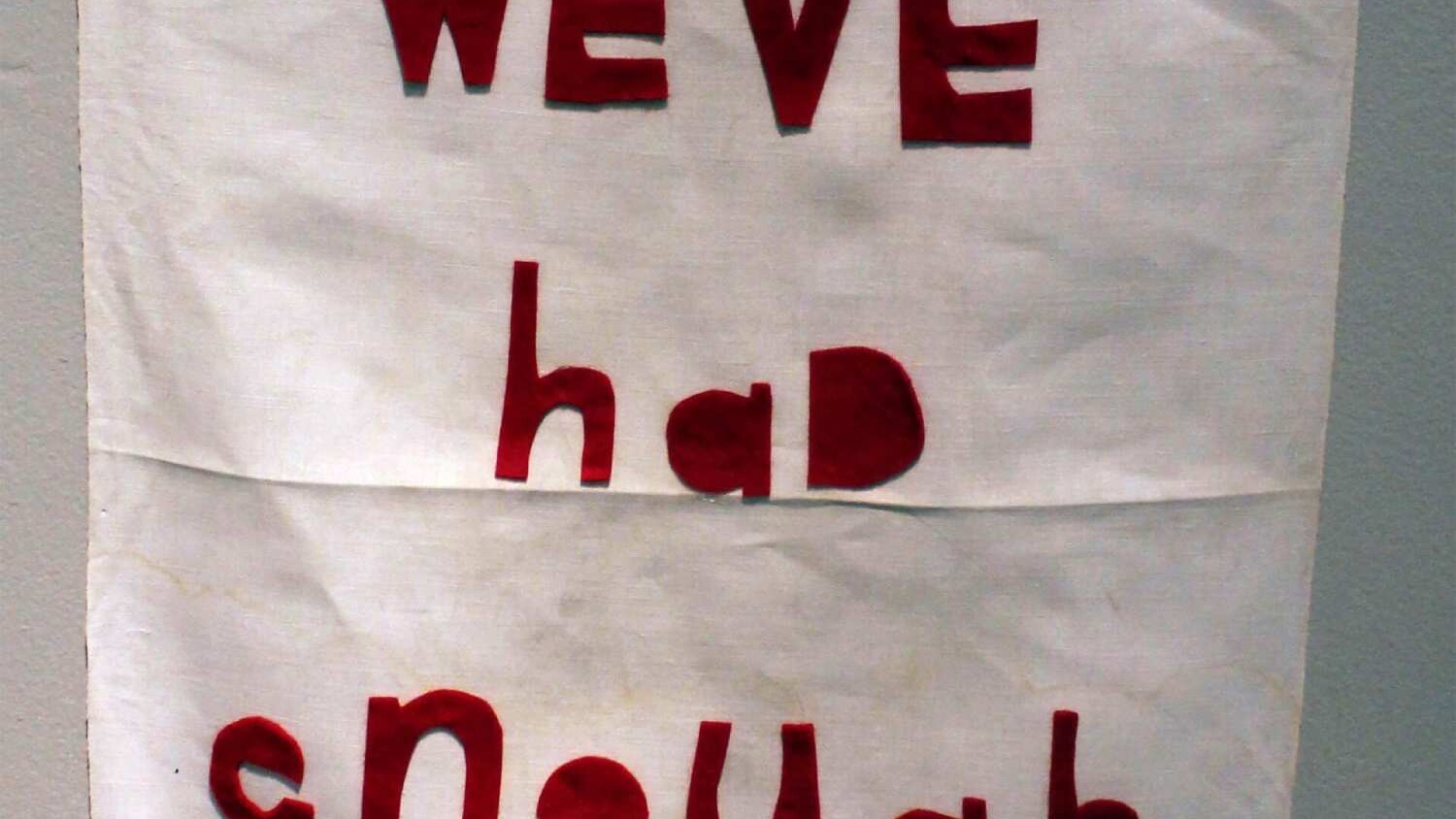
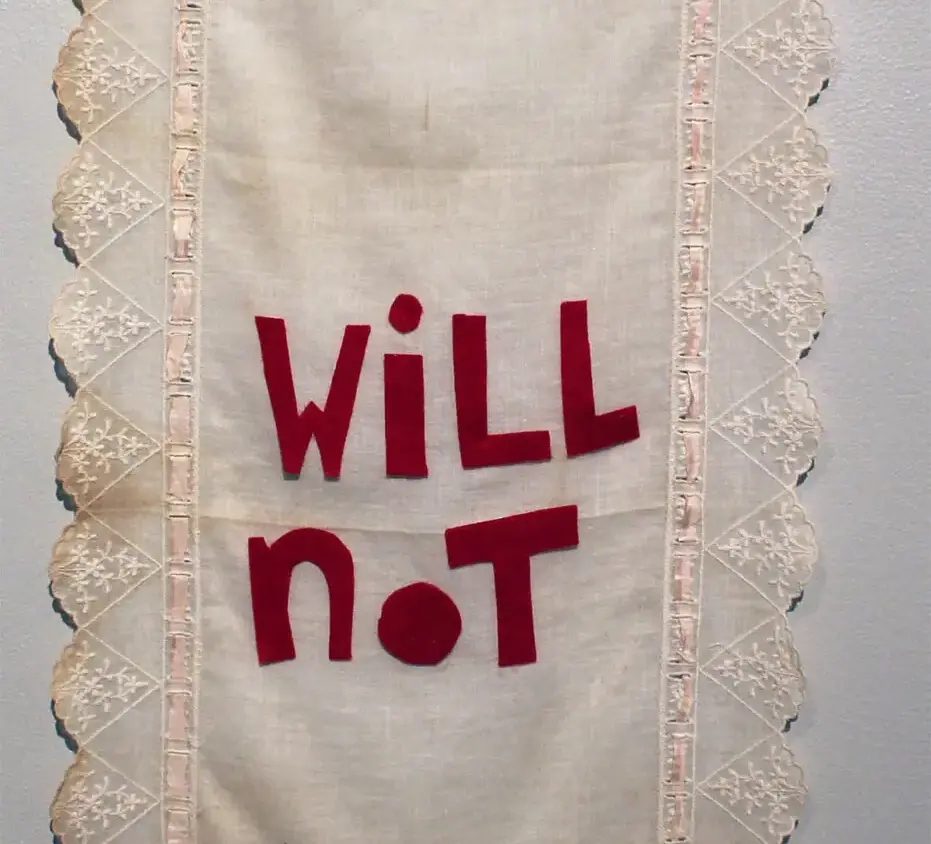
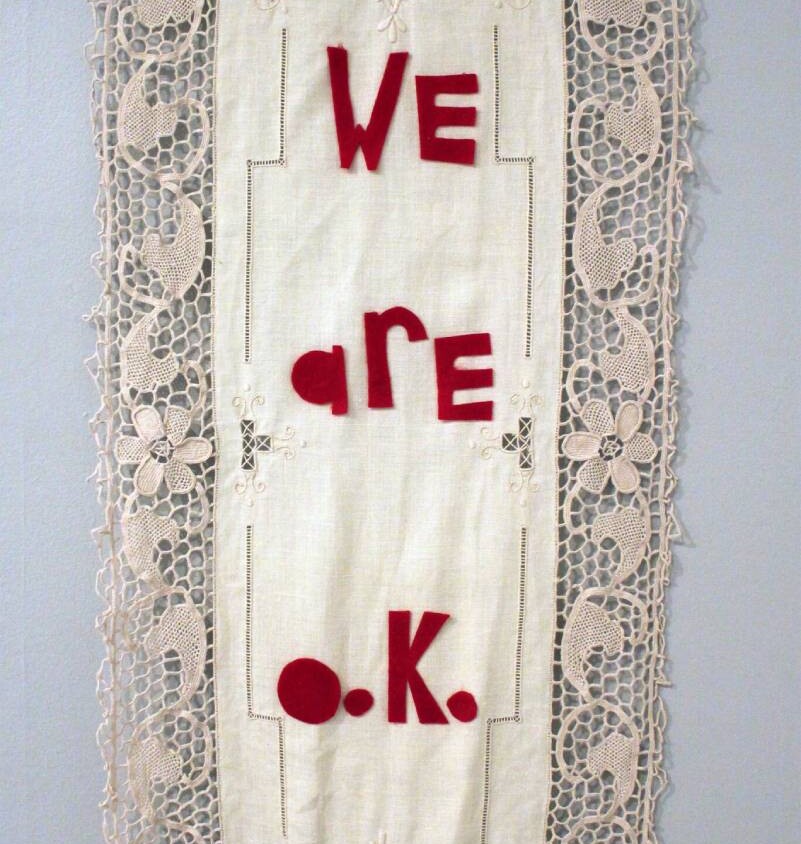
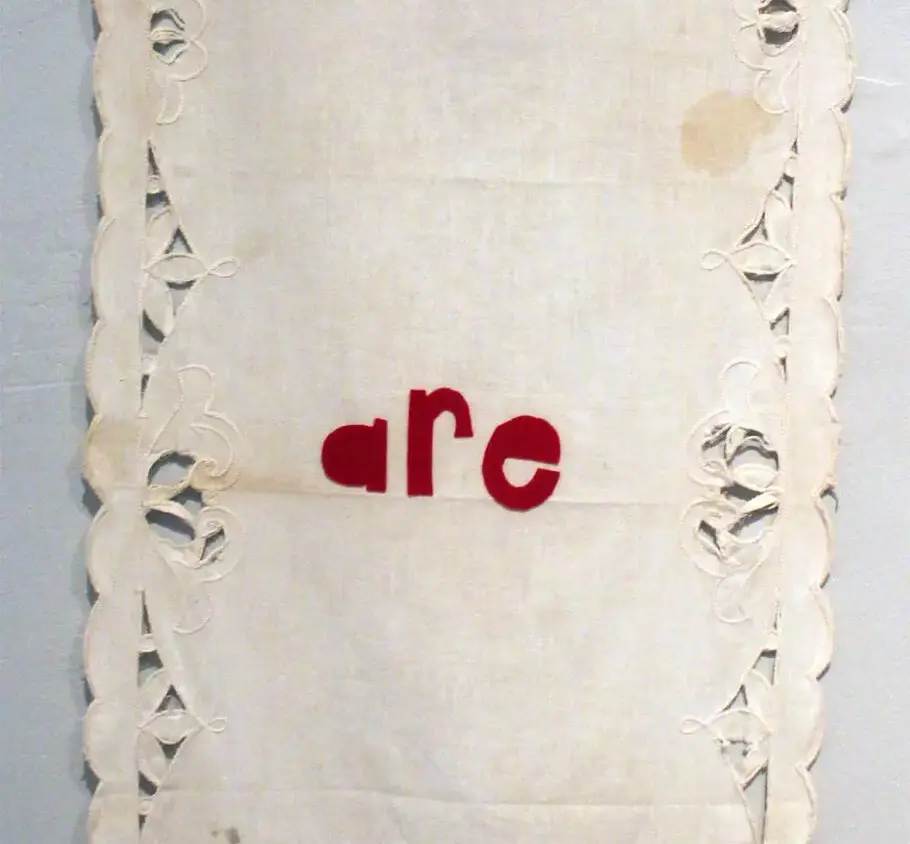
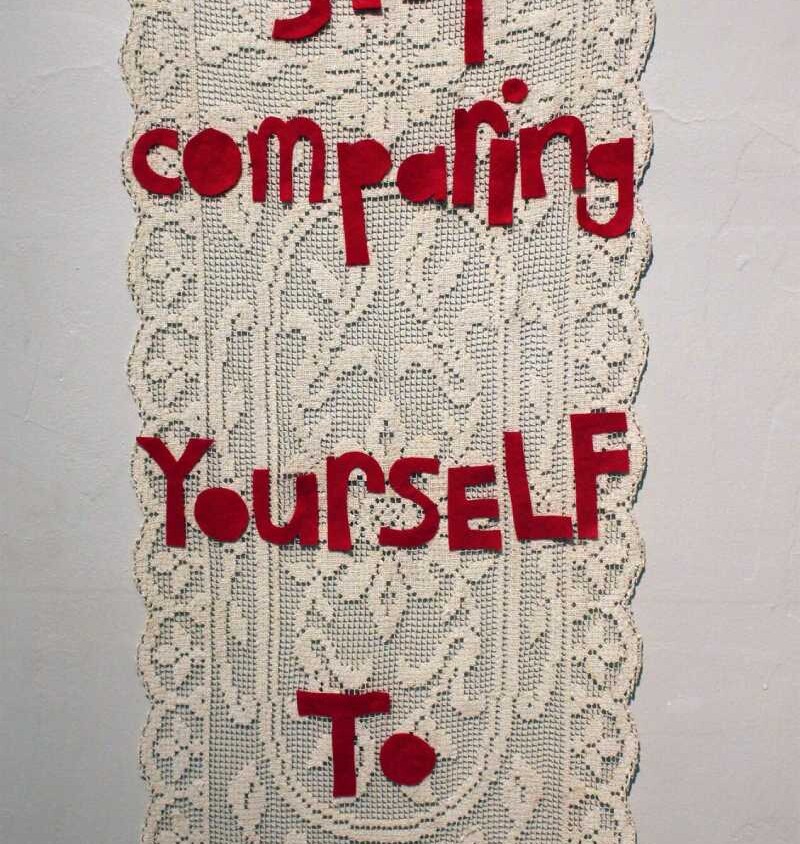





Carole Loeffler, We've Had Enough, 2018, felt, glue, vintage doily, Courtesy of the artist
Carole Loeffler, I Will Not Break, 2018, felt, glue, vintage doily, Courtesy of the artist
Carole Loeffler, We Are Ok, 2018, felt, glue, vintage doily, Courtesy of the artist
Carole Loeffler, You Are Strong, 2018, felt, glue, vintage doily, Courtesy of the artist
Carole Loeffler, Stop Comparing Yourself to Others, 2018, felt, glue, vintage doily, Courtesy of the artist
Carole Loeffler, We've Had Enough, 2018, felt, glue, vintage doily, Courtesy of the artist
Carole Loeffler, I Will Not Break, 2018, felt, glue, vintage doily, Courtesy of the artist
Carole Loeffler, We Are Ok, 2018, felt, glue, vintage doily, Courtesy of the artist
Carole Loeffler, You Are Strong, 2018, felt, glue, vintage doily, Courtesy of the artist
Carole Loeffler, Stop Comparing Yourself to Others, 2018, felt, glue, vintage doily, Courtesy of the artist
This project also synthesizes into a single gesture several distinctive approaches found in feminist art from the ‘60s and ‘70s, most notably the convention of using dialogue to advocate for social change. In this regard, artists such as Barbara Kruger and Jenny Holzer come to mind, although Loeffler’s texts, entirely devoid of irony, are related more to adages found on traditional needlepoint samplers. The use of collage harkens to the strategy of employing skills and crafts typically associated with women or homemaking within a fine art context popularized by artists such as Faith Ringgold and Miriam Shapiro. Despite these insightful nods to feminism’s political and artistic past, it is Loeffler’s own unique sense of immediacy, forthrightness, and wit that shines through most brightly in this exhibition.
Akin to viewing century-old suffragette banners in an archive, the viewer’s experience of these recreated messages—which Loeffler originally intended for city neighborhoods—is no doubt altered, deprived as they are of their original context. The sensation is perhaps similar to the disconnect one feels when seeing a doily, or, for that matter, the words “We are Ok”, both of which seem better suited to a gentile front parlor, pinned to an electrical pole on a city street. On further reflection, however, perhaps this is an underestimation bred by familiarity. How similar is this reaction to that of men who once questioned whether a woman had the intellectual capacity to vote, or, similarly, those individuals in power today who continue to dismiss the social and political concerns of large portions of the population still fighting for equal status? From this perspective, there should be no environment in which Loeffler’s messages should not feel right at home.
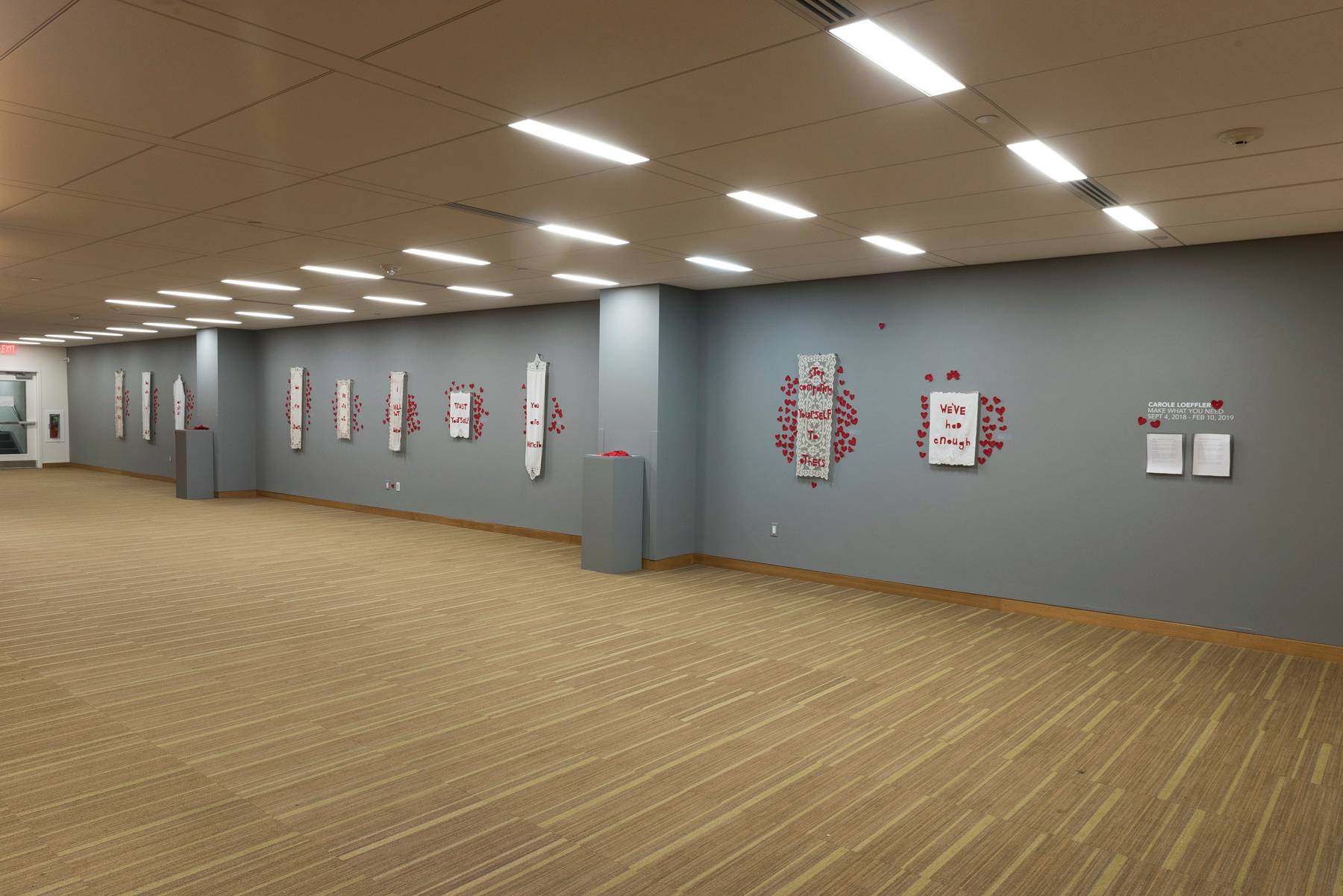
Installation view, "Carole Loeffler: Make What You Need", Rosedale Gallery, photo: Sam Fritch
ABOUT THE CAROLE LOEFFLER
Loeffler is a native of New Jersey and received her B.F.A. from Mason Gross School of the Arts at Rutgers University and her M.F.A. from University of South Florida in Tampa. Previously, she taught and directed the Foundations program at Southern Illinois University Carbondale in the School of Art and Design. Currently, she is the Chair of the Department of Visual and Performing Arts at Arcadia University in Glenside, Pennsylvania and teaches Sculpture, Senior Seminar and coordinates the Foundations program.
While residing in the Mid-west Carole had numerous solo and group exhibitions in New York, St. Louis, Chicago, Cleveland, North Carolina, Indiana and Florida. Since relocating to the East Coast, she has had her work in regional exhibitions in Connecticut, Delaware, Maryland, Philadelphia and throughout the United States. She spent over 10 years investigating the color red through a variety of abstract sculptural approaches and processes. Most recently, she has been utilizing found vintage textiles with text to examine what it means to be a woman in our culture.
Carole lives in Philadelphia with her husband, two children and their dog Happy Smile.
“Carole Loeffler: Make What You Need” is the first iteration of a planned series of shows which focuses on the creative research of the University’s art and design faculty. Loeffler will give a lecture on October 1, 2018 at 4:30 PM in the University Commons Great Room. An opening reception will be held immediately afterward in the Rosedale Gallery. Light refreshments will be served. Both events are free and open to the public.
The exhibition is curated by Matthew Borgen, and was made possible by a donation from Theresa and John Rollins. For more information about the exhibition, please contact Arcadia Exhibitions at (215) 517-2629 or borgenm@arcadia.edu.
